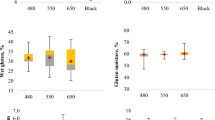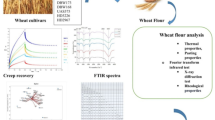Abstract
In this study, we sourced 37 commercial flours from 14 mills based on 7 countries and analysed them with a total of 18 methods, generating 90 single analytical values for each flour. The 18 methods were chosen to cover the analytical practice of most European mills and bakery companies, as well as particle charge detection, GlutoPeak and solvent retention capacity as emerging methods. We investigated the relationship between the data from the individual methods, and performed a principal component analysis to describe the structure of the data set and identify the main underlying flour properties. Four principal components accounted for 64.8% of the total variance. They were interpreted as (PC1) starch gelatinization properties, (PC2) hydration properties, (PC3) dough resistance at variable water amount, and (PC4) dough strength at fixed water amount. From the emerging methods, solvent retention capacity (sodium carbonate and water) was highly correlated with PC2, while the GlutoPeak max torque was highly correlated with PC4.


Similar content being viewed by others
References
Aamodt A, Magnus EM, Faergestad EM (2003) Effect of flour quality, ascorbic acid, and DATEM on dough rheological parameters and hearth loaves characteristics. J Food Sci 68:2201–2210
Barak S, Mudgil D, Khatkar BS (2013) Relationship of gliadin and glutenin proteins with dough rheology, flour pasting and bread making performance of wheat varieties. LWT-Food Sci Technol 51:211–217
Cauvin S (2015) Technology of breadmaking. Springer, Heidelberg
Dabčević T, Hadnađev M, Pojić M (2009) Evaluation of the possibility to replace conventional rheological wheat flour quality control instruments with the new measurement tool—Mixolab. Agric Conspec Sci 74:169–174
Dalla Marta A, Grifoni D, Mancini M, Zipoli G, Orlandini S (2011) The influence of climate on durum wheat quality in Tuscany, Central Italy. Int J Biometeorol 55:87–96
Deffenbaugh LB, Walker CE (1989) Comparison of starch pasting properties in the Brabender Viscoamylograph and the Rapid Visco-Analyzer. Cereal Chem 66:493–499
El-Hady EA, El-Samahy SK, Brümmer JM (1999) Effect of oxidants, sodium-stearoyl-2-lactylate and their mixtures on rheological and baking properties of nonprefermented frozen doughs. LWT-Food Sci Technol 32:446–454
Fierens E, Helsmoortel L, Joye IJ, Courtin CM, Delcour JA (2015) Changes in wheat (Triticum aestivum L.) flour pasting characteristics as a result of storage and their underlying mechanisms. J Cereal Sci 65:81–87
Fremaux A (2015) Bake-off bakery markets in the EU. Gira, Paris
Fu BX, Wang K, Dupuis B (2017) Predicting water absorption of wheat flour using high shear-based GlutoPeak test. J Cereal Sci 76:116–121
Hammed AM, Ozsisli B, Ohm JB, Simsek S (2015) relationship between solvent retention capacity and protein molecular weight distribution, quality characteristics, and breadmaking functionality of hard red spring wheat flour. Cereal Chem 92:466–474
Huen J, Börsmann J, Matullat I, Böhm L, Stukenborg F, Heitmann M, Zannini E, Arendt EK (2017) Pilot scale investigation of the relationship between baked good properties and wheat flour analytical values. Eur Food Res Technol. doi:10.1007/s00217-017-2975-2
Koksel H, Kahraman K, Sanal T, Ozay DS, Dubat A (2009) Potential utilization of Mixolab for quality evaluation of bread wheat genotypes. Cereal Chem 86:522–526
Kweon M, Slade L, Levine H (2011) Solvent retention capacity (SRC) testing of wheat flour: principles and value in predicting flour functionality in different wheat-based food processes and in wheat breeding—a review. Cereal Chem 88(6):537–552
Li J, Hou GG, Chen Z, Chung A-L, Gehring K (2014) Studying the effects of whole-wheat flour on the rheological properties and the quality attributes of whole-wheat saltine cracker using SRC, alveograph, rheometer, and NMR technique. LWT Food Sci Technol 55(1):43–50
Longin F, Ringer L, Lösche K, Starck N, Römer P (2015) Development of germplasm and strategies for sustainable breeding of Emmer (Triticum dicoccum) for organic farming in Germany, BÖLN project report. http://orgprints.org/27958/1/27958-10OE059-V-uni-hohenheim-longin-2014-qualitaetszuechtung-emmer.pdf. Accessed 20 Apr 2017
Ma S, Li L, Wang XX, Zheng XL, Bian K, Bao QD (2016) Effect of mechanically damaged starch from wheat flour on the quality of frozen dough and steamed bread. Food Chem 202:120–124
Marti A, Augst E, Cox S, Koehler P (2015) Correlations between gluten aggregation properties defined by the GlutoPeak test and content of quality-related protein fractions of winter wheat flour. J Cereal Sci 66:89–95
Marti A, Ulrici A, Foca G, Quaglia L, Pagani MA (2015) Characterization of common wheat flours (Triticum aestivum L.) through multivariate analysis of conventional rheological parameters and gluten peak test indices. LWT-Food. Sci Technol 64(1):95–103
Peña RJ, Posadas-Romano R (2013) Potential use of the mixolab in wheat breading. In: Dubat A, Rosell CM, Gallagher E (eds) Mixolab: a new approach to rheology. AACC International Inc, St. Paul, pp 79–84
Schick J, Lösche K (2010) Characterization of milled grain products by particle charge detection. In: Keil HM (ed) Review “Bread”, f2m food multimedia, Hamburg, pp 130–139
Semenov MA, Stratonovitch P, Alghabari F, Gooding MJ (2014) Adapting wheat in Europe for climate change. J Cereal Sci 59:245–256
Van Bockstaele F, De Leyn I, Eeckhout M, Dewettinck K (2008) Rheological properties of wheat flour dough and the relationship with bread volume. I. Creep-recovery measurements. Cereal Chem 85:753–761
Yu J, Wang S, Wang J, Li C, Xin Q, Huang W, Zhang Y, Zhonghu H, Wang S (2015) Effect of laboratory milling on properties of starches isolated from different flour millstreams of hard and soft wheat. Food Chem 172:504–514
Acknowledgements
The project FLOURplus has received funding from the European Union’s Seventh Framework Programme for research, technological development, and demonstration under Grant Agreement No. 606198. The GlutoPeak device was provided to ttz Bremerhaven by Brabender, Germany. The measurements on the Chopin devices were performed by Chopin Technologies, France.
Author information
Authors and Affiliations
Corresponding author
Ethics declarations
Conflict of interest
The authors declare that they have no conflict of interest.
Compliance with ethics requirements
This article does not contain any studies with human or animal subjects.
Rights and permissions
About this article
Cite this article
Huen, J., Börsmann, J., Matullat, I. et al. Wheat flour quality evaluation from the baker’s perspective: comparative assessment of 18 analytical methods. Eur Food Res Technol 244, 535–545 (2018). https://doi.org/10.1007/s00217-017-2974-3
Received:
Revised:
Accepted:
Published:
Issue Date:
DOI: https://doi.org/10.1007/s00217-017-2974-3




